
| News | Demos | iPhysics | MicroLabs | X-Labs | Q-Physics | Quiz Zone | Links |
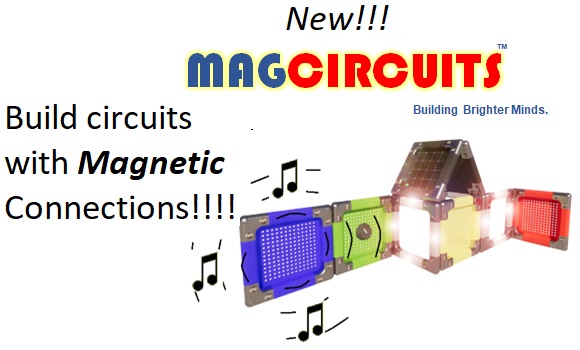 |
 |
A meter stick, yard stick, 1 kilogram mass and 1 pound weight are laid out on a demonstration table for inspection and comparison of relative size. |
 |
A long string of metal washers is constructed such that the first one is 30 cm from the bottom end, the second is 130 cm from the bottom end, and the third is 2.74 m from the bottom end. When the string is released, the washers will sound out at constant time intervals. |
 |
Choose two of the largest students in the class to pull on the opposite ends of a strong 10 m long rope. Ask the students if the rope appears to be straight. Have the smallest student attempt to push down on the middle of the rope with one finger. The small student will easily be able to push the rope down. |
 |
To demonstrate the non-perpendicular components of vectors, tie two loops in the ends of a strong cord that is about 1 m long. Have a student hold a loop in each hand as a classmate carefully hangs a 1 kg mass on the cord. He/she should start with his/her hands together and slowly move them apart. It is not possible to keep the cord straight. |
 |
To quantitatively demonstrate vector addition of forces, attach large dial type spring balances to the top of the chalkboard. Hang a known weight at various points on a string between them. The vectors then can easily be placed on the chalkboard and the equilibrium conditions worked out. |
 |
To qualitatively demonstrate vector addition of forces, attach pulleys and string to a block of wood resting on an incline plane. Taking the "support" board away from the suspended block reveals a force vector equilibrium. The vectors then can easily be placed on the chalkboard and the equilibrium conditions worked out. |
 |
Two identical weights are suspended by identical threads. Threads tied to the bottoms are pulled with different motions. The first is pulled with a slow pull-which causes the top thread to break. The second is pulled with a quick jerk-which causes the bottom thread to break. |
 |
Hold a kitchen knife with a sharp point vertically, and hang half an eggshell over the point. Challenge someone to puncture the shell by rapping the knife handle on a table or kitchen counter. Each time one tries the shell bounces off the tip of the knife unharmed. Hold the blade loosely in your hand. Make this appear as if you rap the handle on the counter when in fact you allow the knife to fall by its own weight so that it hits the counter and bounces. The imperceptible bounce sends the knife point through the shell. |
 |
Poke a hole in the bottom of a plastic water bottle. Fill the bottle 3/4 full of colored water. Drop the bottle into a container. While in freefall, the absence of pressure will stop the water from pouring out. |
 |
Two metal spheres are simultaneously released by a spring-loaded device. One of the spheres drops vertically, the other is projected with horizontal speed. One can hear both hit the floor at the same time. |
 |
A pail of water is whirled in a vertical circle without spilling the water when the central acceleration is greater than or equal to the gravity. |
 |
A toy rocket is attached to a nylon line, which is threaded through a fire polished glass tube. The glass tube is mounted to the top of a ring stand. A hook is attached to the other end of the line for hanging various weights. When the rocket is tossed with tangential velocity, the resulting centripetal force assists in balancing the weight. The rocket will "orbit" many times before coming to rest on the "Earth". Questions to explore include:
|
 |
The set of bifilarly suspended steel balls produce highly elastic collisions. Various combinations of balls can be dropped to illustrate conservation of momentum and energy. |
 |
A set of bifilarly suspended steel balls, of sequentially varying mass, dramatically demonstrate the law of conservation of momentum and energy. |
 |
Have two students sit facing each other on skateboards, approximately 3 m apart. Place a rope in their hands. Tell one to pull on their end of the rope. Ask the class which person is exerting more force. Both students will accelerate toward each other. |
 |
The rocket is filled one third full of water and the remaining volume with compressed air. Velocities in excess of 30 m/s and heights of over 50 meters can be achieved. |
 |
A cardboard box is filled with crumpled newspaper so that a thrown baseball makes an inelastic collision with the box. By measuring the recoil distance it slides, the frictional force of sliding, and the mass of the box, the impact velocity can be calculated. |
 |
A 1 kg weight can be placed at various distances from the axis of rotation. The student is challenged to bring the bar to a horizontal level. |
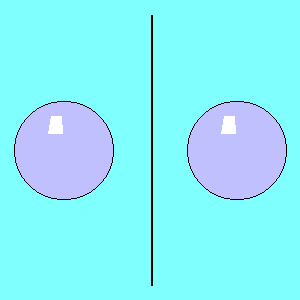 |
Two 1-pound, 2-inch diameter, chrome steel spheres are smashed together with a piece of paper in between. After the collision, a charred hole that smells like smoke, remains in the paper. |
 |
Fill two balloons with air and attach them to the ends of a meter stick. Balance the meter stick on a narrow edge. Use a pin to release the air from one of the balloons. The meter stick should now tilt toward the balloon that is still filled with air. Ask students to explain why. |
 |
Two two-liter bottles are connected with a clear plastic tubing running between them. The column of water is balanced against a column of air and water. The water seems to rise higher than the surface of its reservoir. |
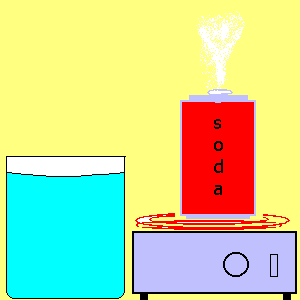 |
Vaporize a few drops of water in a beverage can using a hotplate. With tongs, quickly invert the can and plunge it into a large beaker filled with cool water. The loss of internal pressure, due to the rapid condensation of the water vapor, will allow atmospheric pressure to implode the beverage can. |
 |
A one gallon can is evacuated with a pump and is subsequently crushed by the atmospheric pressure. Alternatively, the can can be crushed by vaporizing a small amount of water and capping the can. Upon cooling, the vapor returns to liquid and loses pressure. |
 |
A large flask with a few drops worth of water heated to steam is fitted with a balloon. As the flask cools down, atmospheric pressure pushes the balloon down into the flask. |
 |
A medicine dropper is partially filled with water so that it is just buoyant in a water filled whiskey bottle. Squeezing the broad sides of the bottle increases the pressure in the bottle which is translated to the just buoyant medicine dropper. The reduced volume of the dropper allows it to sink. |
 |
A layered mixture of water and alcohol has a region of density equal to that of vegetable oil. As oil is added to the mixture, it sinks to a stable depth and collects into a large spherical drop under the action of the oil's surface tension. |
 |
A nozzle projecting a jet of high velocity air can suspend various objects such as ping-pong balls, etc. The viscous force of air balance the weight and the low pressure in the jet keeps the object trapped in the air-stream. |
 |
This commercially available toy demonstrates the conversion of thermal energy to mechanical energy. As it dips its beak into a glass of water evaporative cooling induces the rise of volatile liquid from his tail toward his head. As he dunks, the liquid returns to his tail, the bird rises, and the process repeats. |
 |
A laminated bar made from two different metals fastened in a wooden handle is placed over a flame. The different thermal expansion rates cause the bar to bend. |
 |
A dramatic illustration of the caloric content of food can be conducted by burning a dry-roasted peanut on the end of a long pin. The peanut will burn for about one minute. It's surprising to students to discover the differences in the physical properties of the peanut after it has burned. |
 |
A sample of water is heated using a small segment of nichrome wire and a Genecon generator. By measuring the force needed to turn the crank, the lever-arm length, and counting the revolutions needed to raise the temperature of the water 10°C, a comparison of mechanical and thermal energy can be obtained. The student will most likely gain a greater appreciation of 10 cents worth of electricity following this demonstration. |
 |
The commercially available radiometer has four vanes, white on one side and black on the other. The vanes are mounted in a glass bulb. As light strikes it from the side, the absorbed photons heat the black side which heats the surrounding air molecules which then bounce off the vane imparting momentum. |
 |
A clear plastic pouch of sodium acetate releases latent heat upon crystallization. |
 |
A DC motor is fitted with a small pulley attached to a swivel. The other end of the rope is attached to a stand with a swivel. As the speed of the motor is adjusted various numbers of nodes and loops can be created. A stroboscope can be used to "stop" the motion. |
 |
A tuning fork is held above a tube, the bottom of which is closed by the water in a 1 L graduated cylinder. The tuning fork and tube are raised and lowered together. The air column in the tube will resonate strongly at odd multiples of one fourth wavelengths of the fork. |
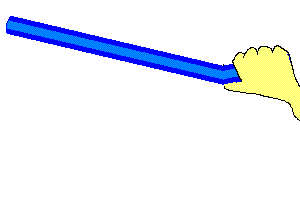 |
A long corrugated plastic tube, open on both ends, is whirled around in a circle. The fundamental and several harmonics may be excited by whirling it at various speeds. |
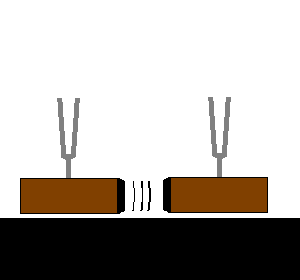 |
Two identical tuning forks are mounted on wooden resonance boxes. One of the tuning forks is excited and immediately dampened. The second tuning fork will resonate in sympathy with the first. |
 |
A 0.3 m section of discarded garden hose will produce a trumpet sound when blown as one blows a trumpet. Changing the length will change the pitch of the "trumpet". |
 |
A tin can or paper tube is covered on one end by aluminum foil or Mylar film. The aluminum foil should be stretched tight over the tube and held in place with a rubber band or tape. Sing and hold a note (the best you can) into the open end of the tube while reflecting the laser off of the center of the foil. Interesting Lissajous figures will appear. |
 |
Credit for this technology goes to Alexander Graham Bell (who reportedly used the sun as the light source). A tin can or paper tube is covered on one end by aluminum foil or Mylar film. The aluminum foil should be stretched tight over the tube and held in place with a rubber band or tape. Speak into the open end of the tube while reflecting the laser off of the center of the foil. The modulated signal is then picked up by a solar cell and amplified by a small audio amplifier. |
 |
A periscope is constructed from two plane mirrors set at 45° angles in a cardboard tube. The top of the periscope is constructed such that it can be rotated. When the top of the periscope is rotated 180° the image produced is upside down. Properties of plane mirror reflection can be demonstrated. |
 |
A polystyrene cup with a coin at the bottom is placed on a table. A student is asked to stand far enough away so that the coin is just out of view. As water is poured into the cup the coin comes into view. |
 |
A block of wax is mounted 50 cm away from a hotplate. Without the concave mirror behind it the wax will not melt. |
 |
Of the two concave mirrors the top one has a 4 cm hole so that light can escape. A coin is placed at the bottom of the bottom mirror. A surprisingly faithful three dimensional image is created in the opening. |
 |
Punch a small hole near the bottom of a 1-L soft drink bottle. Fill the bottle with water. As the laser light exits the hole with the water, the water will appear red. Secretly depositing a drop of red food coloring in the pail can be humorous. |
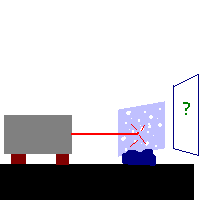 |
A laser beam is directed onto a single slit cut into metal foil. Single slits of various widths may be shown to illustrate how the diffraction pattern width varies with the slit width. |
 |
The polarization of laser light can be shown by rotating sheets of polarized film in the path of the laser beam. |
 |
The polarization of light from a flat panel display can be shown by rotating sheets of polarized film in the path of emitted light. |
 |
An electroscope is constructed from a pop can taped to a Styrofoam cup. Thin strips of aluminum foil are hung from the pull tab. Electrically charged objects can then be introduced and studied. You can use this electroscope in Modern Demo #1. |

 |
A charged ebony rod is placed in proximity to an electroscope. The induced charge causes the leaves to separate. |
 |
A Styrofoam cup, half-filled with puffed rice, is placed on top of a Van de Graff generator. When the generator is turned on a fountain of charged particles is made. |
 |
The current generated by the Genecon generator creates a magnetic field that interacts with the compass needle. |
 |
A neodymium magnet is dropped into a copper pipe. The falling magnet (changing magnetic field) induces a current that circulates through the copper pipe. The direction of the induced current is such that the induced magnetic field opposes the change in magnetic field of the falling magnet. The magnet floats in mid air. |
 |
The electrical energy generated by the Genecon generator can be stored in a 1 Farad capacitor, and then be used to perform short term tasks. |
 |
The voltage generated by a Genecon generator (~6 V) can be stepped up sufficiently to light a 60 V Neon lamp using a buzzer and a 1:10 step up transformer. |
 |
A coil, made from magnet wire, and a magnet are taped to the bottom of a plastic drinking cup. When a hand generator is hooked up to the coil, the fluctuations in the generator current can be heard. |
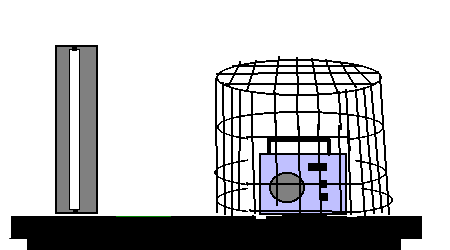 |
Place a florescent light source next to a radio tuned to a weak AM station. Once a wire cage is placed over the radio the static will go away. |
 |
A thin 70 cm long strip of aluminum foil is taped at both ends to a stand. Applying a current (8 V) to the loop causes the foil to repel. |
 |
A thin 70 cm long loop of aluminum foil is taped to a stand. Applying a current (8 V) through the loop causes the foil to attract. |
 |
A neodymium disc magnet is suspended from the positive end of a 1.5 V battery with a wood screw (or nail). When current is applied to the side of the magnet, with a wire from the negative end of the battery, the magnet spins with high angular speed. |
 |
A neodymium sphere magnet is suspended between the points of two wood screws. As current passes from the side of the magnet to the bottom, the magnet spins. |
 |
The efficiency of Genecon generators can be compared by hooking two together, and calculating the ratio of input turns to output turns. |
 |
The electrical resistance of a section of nichrome wire is shown to be a function of wire length. |
 |
A piece of thread is tied around a neodymium magnet. The magnet rapidly aligns with the earth's magnetic field once suspended. |
 |
Neodymium magnets (salvaged from an obsolete computer hard drive) are placed on either side of one's hand. The magnetic field is strong enough to hold the magnets firmly in place when separated by the thickness of one's hand. |
 |
Neodymium magnets are strong enough to attract the trace amounts of iron in American currency. |
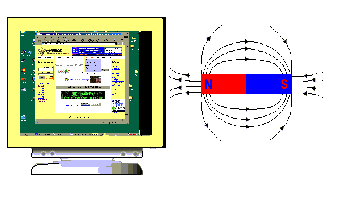 |
Using an obsolete TV or computer monitor, the image on the screen can be displaced when a magnet is moved nearby. From this, one can reasonably infer that the magnet is deflecting the electron beam inside the picture tube. |
 |
Sand the top side of the homemade electroscope (Electricity Demo #1) exposing the bare aluminum. Negatively charge the electroscope with a balloon that has been charged. Shine a flashlight and/or long-wave black light on the electroscope and it remains charged. Shine a UV-C germicidal hand sterilizer on it and it discharges. Placing a glass plate between the UV-C source and electroscope will block the UV and prevent the electroscope from discharging. |
 |
A light-emitting diode is connected in series with a 200 ohm resistor to a three volt source. The one-way nature of conduction is then shown. |
 |
The absorption or emission of heat energy when electrons move from one state to another across dissimilar semiconductor junctions is known as the Peltier effect. Connect the Genecon generator to a commercially available thermoelectric device. Turn the handle one way, and the plate heats up. Reverse direction, and the plate cools down. |
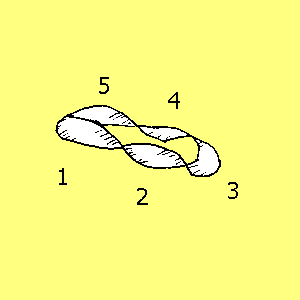 |
An analogy between the number of turns in a Mobius strip and the principle quantum number can be made. The analogy can also be extended to the DeBroglie wavelength. |